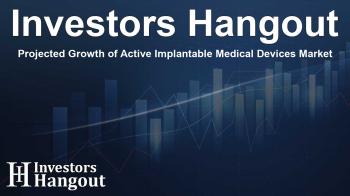Projected Growth of Active Implantable Medical Devices Market

Understanding Active Implantable Medical Devices Market Growth
The Active Implantable Medical Devices Market has shown considerable potential, expanding from USD 25.48 billion in recent years to an estimated USD 33.76 billion soon. This translates into a remarkable compound annual growth rate (CAGR) of 8.20% projected over the forthcoming years. The sector is primarily driven by advances in technology and increasing health challenges that necessitate innovative medical solutions.
Defining Active Implantable Medical Devices
An Active Implantable Medical Device (AIMD) is an innovative implant that requires an external power source, commonly electricity, to function effectively. A well-known example is a pacemaker, which has revolutionized cardiac care. Such devices play a pivotal role in managing specific health conditions by integrating technology with healthcare.
The Evolution of AIMD Technology
The journey of AIMDs commenced with the implantation of the first electronic pacemaker in the late 1950s. Over the decades, advancements have dramatically improved their functionality, battery life, and programmability. The introduction of devices like the ICD has reshaped the landscape of cardiac treatment, making it crucial for patients with life-threatening arrhythmias.
Drivers Fueling Market Expansion
Several factors contribute significantly to the expansion of the AIMD market:
Rising Incidence of Cardiac Conditions
The prevalence of arrhythmias and sudden cardiac arrest is on the rise, driving the demand for Implantable Cardioverter Defibrillators (ICDs). With global statistics indicating millions of deaths from cardiac ailments annually, the necessity for effective treatment options cannot be overstated. The use of ICDs, which can deliver life-saving shocks to restore heart rhythm, is increasing.
Chronic Diseases and Aging Population
Another key aspect driving growth is the increase in chronic diseases and an aging population around the globe. Conditions such as cardiovascular diseases, neurological disorders, and diabetes are exacerbating the need for AIMDs. These devices not only enhance quality of life but also support long-term management of these varying health issues, proving essential for elderly patients.
Challenges Facing the Market
Despite the steady growth, the AIMD market faces significant challenges. Stringent regulatory approval processes can delay product launches and inflate development costs. Companies must navigate complex testing protocols mandated by regulatory bodies to ensure the safety and efficacy of these devices.
Key Contributors to the Market
Identifying the primary players in the AIMD market is critical for understanding competitive dynamics. Major manufacturers such as Medtronic, Abbott Laboratories, Boston Scientific, and Cochlear Ltd. are at the forefront, driving innovation and growth through their advanced product portfolios.
Recent Developments Shaping the Industry
Recent advancements in the industry highlight the dynamic nature of AIMDs. For instance, Stryker's acquisition of SERF SAS signifies an expansion of its orthopedic offerings and fortifies its commitment to innovation. Similarly, new manufacturing facilities for Active Implants in the UK show a commitment to enhancing capabilities to meet rising healthcare demands.
Market Segmentation Insights
The AIMD market can be segmented by type, application, and region. Currently, pacemakers and ICDs dominate the product types due to their critical role in cardiovascular health. In application terms, hospitals remain the primary market as they are key sites for both implantation and postoperative care.
Regional Market Dynamics
North America leads the global AIMD market, bolstered by its advanced healthcare infrastructure and high levels of investment in medical technology. As chronic diseases become more prevalent, the demand for AIMDs is expected to grow, particularly in the United States.
Future Outlook
As technological advances continue to evolve, the Active Implantable Medical Devices Market looks poised for steady growth. The future undoubtedly holds vast improvements in device safety, efficiency, and accessibility, which will be critical in addressing the health challenges posed by an aging global populace and rising chronic disease instances.
Frequently Asked Questions
What are Active Implantable Medical Devices?
Active Implantable Medical Devices are medical devices that require an external power source to function, such as pacemakers and implantable defibrillators.
What is the expected market growth for AIMDs?
The market is projected to grow from USD 25.48 billion to USD 33.76 billion by 2032, with a CAGR of 8.20%.
What are the primary drivers of market growth?
Key drivers include the rise in cardiac diseases, chronic illness prevalence, and an aging population needing long-term care.
Who are the leading manufacturers in the AIMD market?
Leading manufacturers include Medtronic, Abbott Laboratories, Boston Scientific, and Cochlear Ltd., among others.
What challenges does the AIMD market face?
Challenges include stringent regulatory requirements that can delay product releases and increase development costs.
About Investors Hangout
Investors Hangout is a leading online stock forum for financial discussion and learning, offering a wide range of free tools and resources. It draws in traders of all levels, who exchange market knowledge, investigate trading tactics, and keep an eye on industry developments in real time. Featuring financial articles, stock message boards, quotes, charts, company profiles, and live news updates. Through cooperative learning and a wealth of informational resources, it helps users from novices creating their first portfolios to experts honing their techniques. Join Investors Hangout today: https://investorshangout.com/
Disclaimer: The content of this article is solely for general informational purposes only; it does not represent legal, financial, or investment advice. Investors Hangout does not offer financial advice; the author is not a licensed financial advisor. Consult a qualified advisor before making any financial or investment decisions based on this article. The author's interpretation of publicly available data shapes the opinions presented here; as a result, they should not be taken as advice to purchase, sell, or hold any securities mentioned or any other investments. The author does not guarantee the accuracy, completeness, or timeliness of any material, providing it "as is." Information and market conditions may change; past performance is not indicative of future outcomes. If any of the material offered here is inaccurate, please contact us for corrections.
